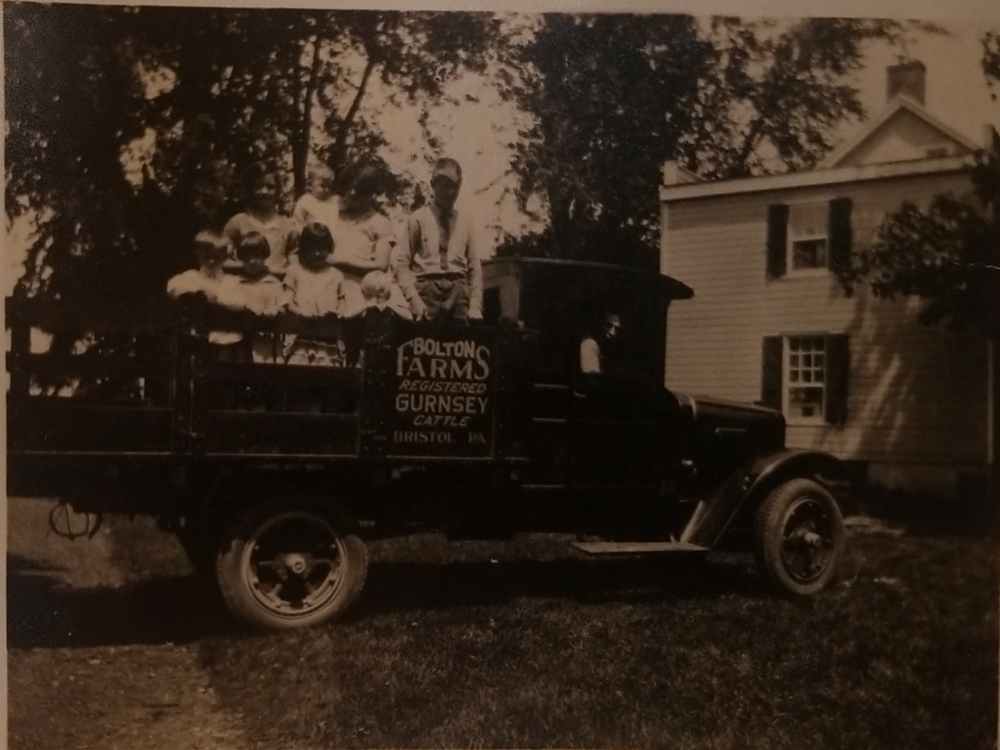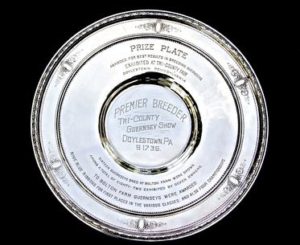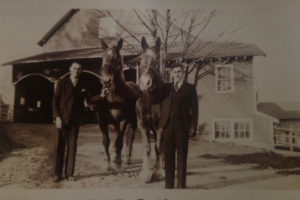“BOLTON FARM” by : Horace Mather Lippincott, ’97 C. 1st, 7th mo.,1946
“Bolton Farm” is located between Fallsington and Emilie on the Fallsington Road in Bucks County, Pennsylvania, about one mile and half from Tullytown Station on the New York Division of the Pennsylvania Railroad.
Following the death in 1937 of Effingham B. Morris, ’75 C., 319,2934 acres of rich, rolling land, numerous valuable farm building, all equipment, and a prize winning herd of pure bred registered Guernsey cattle were presented by Morris’ heirs to the University, {University of Pennsylvania} of which he was for many years a trustee. This gift was of out-standing importance to the University because of its bearing upon the development of the School of Veterinary Medicine. The need of such a farm had been stressed for several years by G. A. Dick, ’04 V., while serving as Dean of the Veterinary School.

Phineas Pemberton

In 1946 the handsome colonial house of great historical distinction plus about 50 acres of land which was reserved when the original gift was made was purchased by the Trustees of the University from the heirs of Mr. Morris and added to the original gift to be used for research purposes.
A portion of William Penn’s Manor of Pennsbury was purchased by Phineas Pemberton who came from Radcliffe Bridge near Bolton in Lancashire, England, with his father, Ralph Pemberton; his father-in-law, James Harrison; and a large household, to Bucks County in 1682 when the Quakers were being sorely persecuted in native Lancashire. His mother was Margaret Seddon, who died in 1655. Phineas was born at Aspul, January 30, 1650, and died at Bolton Farm in Bucks County, Pennsylvania, March 1, 1702. James Harrison and Ralph Pemberton died in 1687 and Anne heath Harrison, widow of James, in 1690. Phineas Pemberton and his father-in-law, James Harrison, a Minister of the Society of Friends, were imprisoned several times in England on account of their Quaker faith. The mob before Pemberton’s door shouted, “Come out thou Papist dog, thou Jesuit, thou devil, come out!”
At the Philadelphia Yearly Meeting held at Burlington, New Jersey, (opposite Pennsbury on the Delaware) in 1683, Phineas Pemberton said “Remember we were a despised people, in our native land, accounted by the world scarce worth to have a name or place therein; daily liable to their spoil; under great sufferings, by long and tedious imprisonment, sometimes to the loss of life – banishment, spoil of goods, beatings, mockings, and ill treatings; so that we had not been a people at this day had not the Lord stood by us. But none of these things were done unto us because of our evil deeds, but because of the exercise of our tender consciences toward our God.” He was a distinguished man, able and educated above the average of the day – “the ablest as well as one of the best men in the Province,” in Penn’s own words. He held the highest public offices in Bucks County and was a member of the Provincial Council of Pennsylvania for five years and of the Assembly for six years, the latter three as Speaker, and was a most prominent leader among Friends. The Provincial Council was presided over by Governor William Penn, Pemberton’s neighbour at Pennsbury who visited the stone farmhouse which Pemberton completed on his place in 1687 and which is part of the present big mansion today.
Radcliffe Bridge
 Radcliffe Bridge, from whence came the Pembertons to America, was one of two small collections of houses in the parish of Radcliffe, Lancashire, England. The other was Radcliffe. Those two villages were clustered about a bridge over the river Irwell and the district, formerly know as the “The Bridge”, is now the business section of the town of Radcliffe and not at all distinct from it. The town is five miles directly west from Bolton and six north from Manchester. The Roman vicinal road from Manchester to Ribchester run through the parish which is in the Union of Bury and Hundred of Salford. it is the smallest parish in the county, consisting of 2,435 acres and is of decidedly Saxon as appears in the Doomsday Book of 1086. Radcliffe was held in the crown until granted by Stephen to Ranulph de Gernons, Earl of Chester. The antiquity of the Radcliffe family is very great and Radcliffe Tower was anciently one of the most considerable manorial residences in Lancashire as William de Radeciivo, one of the Knights of the Grand Inquest, 13 John, was of Radcliffe Tower.” The church is about the age of Henry IV: an ancient Manuscript takes it back to 1282. Spinning and weaving established by the Flemish weavers are the principal industries. Richard Radcliffe came to America with the Pembertons and his descendant, Hon. George Radcliffe, is now United States Senator from Maryland. Bolton was the nearest town to the village in which the Pembertons lived and they are generally accredited to the larger and better-known place.
Radcliffe Bridge, from whence came the Pembertons to America, was one of two small collections of houses in the parish of Radcliffe, Lancashire, England. The other was Radcliffe. Those two villages were clustered about a bridge over the river Irwell and the district, formerly know as the “The Bridge”, is now the business section of the town of Radcliffe and not at all distinct from it. The town is five miles directly west from Bolton and six north from Manchester. The Roman vicinal road from Manchester to Ribchester run through the parish which is in the Union of Bury and Hundred of Salford. it is the smallest parish in the county, consisting of 2,435 acres and is of decidedly Saxon as appears in the Doomsday Book of 1086. Radcliffe was held in the crown until granted by Stephen to Ranulph de Gernons, Earl of Chester. The antiquity of the Radcliffe family is very great and Radcliffe Tower was anciently one of the most considerable manorial residences in Lancashire as William de Radeciivo, one of the Knights of the Grand Inquest, 13 John, was of Radcliffe Tower.” The church is about the age of Henry IV: an ancient Manuscript takes it back to 1282. Spinning and weaving established by the Flemish weavers are the principal industries. Richard Radcliffe came to America with the Pembertons and his descendant, Hon. George Radcliffe, is now United States Senator from Maryland. Bolton was the nearest town to the village in which the Pembertons lived and they are generally accredited to the larger and better-known place.
Phineas Pemberton was apprenticed in his youth to John Abraham, a grocer of Manchester, and his father, Ralph, left his home in Aspul in 1676 and came to Radcliffe Bridge where he kept a grocery store, assisted by Margery Vose. It is from the letters in the Pemberton Collection at the Historical Society of Pennsylvania that we have gleaned much of the information about the family. When the Pembertons went to America the business was sold to Nathaniel Atherton, but Margery Vose seems to have remained in charge. her letters to Ralph Pemberton are full of affection and gossip about the neighbours whom he had left behind.
There is often a postscript signed by Richard Mather, a close friend and father of the youth, Joseph Mather, who came to America with the Pembertons and established the family in these parts. She often speaks of Mathers and sends “my dear love to Joseph Mather.” These were all prominent Quakers and such messages were usual amongst the m. Ralph Pemberton’s replies are equally interesting and constantly mention Richard Mather. The log of the ship SUBMISSION , upon which these Friends came to America, was kept by Phineas Pemberton, and is preserved at the Historical Society of Pennsylvania. James Harrison, father-in-law of Phineas Pemberton, who came with him, became William Penn’s “steward” (manager) at Pennsbury not far distant. It was from their correspondence that much of the information was obtained that enabled R. Brognard Okie, ’97 C., architect, to reconstruct the mansion as the Commonwealth’s tribute and memorial to its great Founder.
Grove Place
Phineas Pemberton married Phoebe, daughter of James and Anna Harrison. These with the venerable Agnes Harrison, mother of James; Joseph and Abigail Pemberton, children of Phineas; Robert Bond, Joseph Mather, and Richard Radcliffe, young men from Radcliffe, sailed on the “Submission” from Liverpool 7 mo., 5th, 1682 (O. S.), after a terrific storm had driven them from their course, or, as some aver, because of the dishonesty of the Captain who obtained “head money” from Maryland, it was said. They left their families at William Dickinson’s for the winter. The site of Philadelphia was a wilderness when they entered it on horseback en route to Bucks County. They could not find shelter for their horses and “spancelled” then in the woods. Next morning they were gone and the party had to proceed by boat to the Falls of the Delaware where they stayed with William Yardley, and uncle of Phoebe Pemberton. One of their horses was not found until the following January. In the spring of 1683, the family and household goods were brought to Bucks County, Pennsylvania, where they stayed at the house of Lyonel Brittain, one of the earliest settlers.
On November 17, 1683, Phineas Pemberton (sometimes spelled and signed, “Phinehas”) purchased 500 acres on the Delaware River opposite Biles (Oreclan’s) Island and built a house there which he called, “Grove Place.” Being desirous of a more comfortable home for his large household he finished one in 1687, on a part of Pennsbury, “Penn’s home, some five miles distant and more in the interior, which he called, “Bolton Farm.”
William Penn writing to James Logan, 9-4-1701, says:
“Poor Phineas Pemberton is a dying man, and was not at the election, though he crept (as I may Say) to Meeting yesterday. I am grieved at it: for he has not his fellow, and without him this is a poor country indeed.”
Again, in a letter from London to Logan, Penn writes,
“I mourn for poor Phineas Pemberton the ablest as well as one of the best men in the Province. My dear love to his widow and sons and daughters.”
James Logan writes to William Penn in similar vein and describes their friend’s death and funeral in a letter of 3/7 1702. He was buried in the family graveyard at “Grove Place”, still maintained by his descendants.
Israel Pemberton
The surviving son was Israel, born 1684 at “Grove Place.” he was educated by his parents and by Francis Daniel Pastorius in Philadelphia. He entered the counting house of Samuel Carpenter, one of the ablest and most affluent Friends of that day. He was Common Councilman, 1713; Alderman, 1720, for a life tenure; and was one of the city’s two members of the Provincial Council for 20 years, beginning 1718. Israel Pemberton was a most active Friend and was dubbed, “King of the Quakers.” He served the Society as Clerk (presiding officer), overseer, and Elder, as well as member of committees. His city residence was at southwest corner of Front and Market Streets from 1718 to 1745, when he removed to the southwest corner of Third and Chestnut Streets, called Clarke Hall. It was the resort of many strangers of note from Europe and famous for its beautiful terraces of gardens with the prospect of the river which they commanded. Israel also awned a place called, “Evergreen,” in 1738 at 23rd and South and Gray’s Ferry Road. he married Rachel, daughter of Charles Read and sister-in-law of James Logan, in 1710.
James Pemberton
Upon the death of Israel Pemberton, Bolton Farm was bequeathed to his son, James, born 1723. He was a widely travelled man at home and abroad, successful in mercantile pursuits as his father had been, and interested in the welfare of the Indians and negroes as befitted a concerned Friend. He was President of the Abolition Society founded by Benjamin Franklin, a founder and manager of the Pennsylvania Hospital, and a member of the Assembly, resigning with all the Quaker members in 1756 when Governor Morris declared was on the Delaware Indians. Opposing war with England, he was exiled with many other prominent Quakers to Virginia in 1777, during which time his wife, Phoebe, ably managed his extensive affairs. His town house was on Second Street adjoining Lodge Alley, now Gothic Street. He also owned “The Plantation”, now occupied by the United States Naval Asylum on the east bank of the Schuylkill River and on the opposite side of Gray’s Ferry Road from the “The Evergreens” which he inherited from his father. The annalist Watson says of him, “He was almost the last of the race of cocked hats, and certainly one of the very best illustrations of bygone times and primitive men.”
James Pemberton married Hannah Lloyd, Sarah Smith, and Phoebe Lewis Morton. A daughter of the second marriage was Mary Pemberton, who married Anthony Morris in 1790, thus joining two of Philadelphia’s most prominent Quaker families. He was the son of Captain Samuel Morris and Rebecca Wistar Morris and was a lawyer and merchant. He inherited Bolton Farm and lived there. Anthony Morris was a State Senator and in 1793 was Speaker of the House. In 1813 he was appointed Minister to Spain. At his death, when 95 years old, he was buried with his wife at “Bolton Farm”, which had been their home for so long a time.
James Pemberton Morris
A son, James Pemberton Morris, married Rosa, daughter of Rev. William Gardiner, LL.D. of Edinburgh, Scotland, and resided at “Bolton Farm” where they, too, are buried. One of their children, Phineas Pemberton Morris, next resided at “Bolton Farm” and dying without issue in 1888, the estate came by will to Effingham B. Morris their cousin, who lived there at intervals during each year. Another descendant of the founder of “Bolton Farm” is Dr. Ralph Pemberton,. ’98, Professor of Medicine in our Graduate School of Medicine ……
It is not too much to say that this magnificent Bucks County estate of 550 beautiful acres with its splendid buildings and handsome Colonial Mansion of great historical importance is one of the finest gifts the University has ever received. It is a fitting memorial to one of Pennsylvania’s most loyal sons, Effingham B. Morris, ’75, a fine Christian gentleman and a citizen of distinguished ability.
